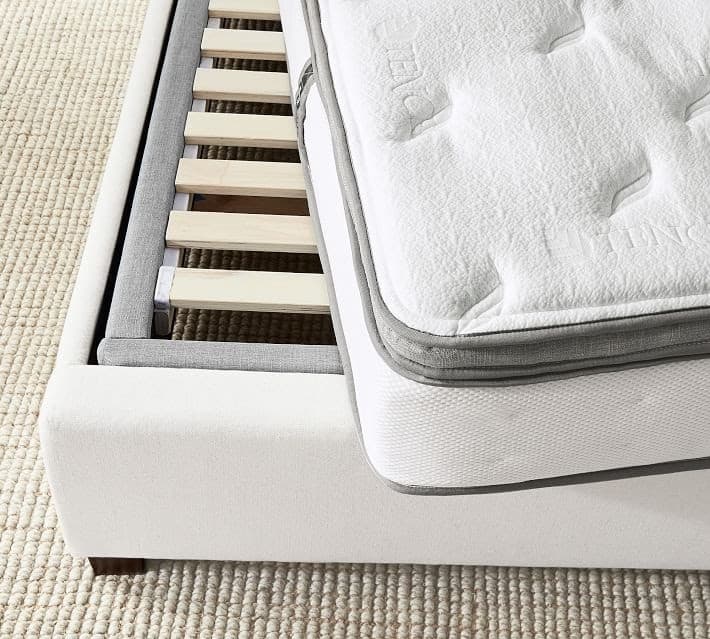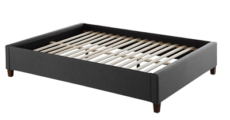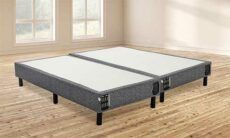The terms “mattress foundation” and “bed frame” are often used interchangeably. However, mattress foundations and bed frames are different things. A mattress foundation is the surface on top of which a mattress rests, usually on top of a bed frame: its purpose is to support your mattress and your body as you sleep and to protect and increase the lifespan of your mattress. A mattress foundation is essential for some types of mattresses, such as memory foam and latex mattresses. A bed frame, on the other hand, is the portion of a bed that surrounds the mattress and holds it up off the floor. Bed frames often consist of four side panels, legs, a headboard, and a footboard, but many of these features are optional. However, you may be wondering what some of the other differences between mattress foundations vs. bed frames are and what you really need.
The main difference between mattress foundations vs. bed frames is that mattress foundations are usually placed on top of a bed frame and provide a flat and sturdy support surface for mattresses. Some bed frames have mattress foundations built-in. You need a mattress foundation if your bed frame doesn’t have built-in support like slats or a bunkie board.
3 great foundations adaptable for all mattresses
A wooden bed frame, for instance, will often have wooden slats that connect to the side panels and serve as a mattress foundation. In these cases, the base and the frame cannot be separated and must stay together to provide mattress support. However, some bed frame models only provide a simple frame around a mattress without any base to support it. In these cases, it’s crucial to invest in a foundation for your mattress because the frame alone won’t sufficiently support the mattress.
What Is a Mattress Foundation?
A mattress foundation is a flat, sturdy surface that typically sits on a bed frame to provide mattress support and even bodyweight distribution.
A mattress foundation can be used to raise a mattress to be higher off the ground and therefore make it easier to get in and out of bed. However, sometimes certain mattress foundations may be too high for short people, and they can sometimes be bulky. Make sure to take a look at our articles to determine if you need a mattress foundation and bunkie boards and other alternatives for more information and ideas.
Different Types of Mattress Foundations
Box Springs
Box springs have been the standard foundation for mattresses for years. Traditionally, they were made of coils and were used beneath an innerspring mattress. Nowadays, they are made of a wooden or metal frame that is covered with fabric. Box springs provide additional height for your bed but aren’t essential, as many new mattresses are firm enough to not require a box spring for support. Zinus makes some excellent box spring mattress foundations that you can buy on Amazon.
Slats
Slats are made of wooden or metal planks and attach to the sides of a bed frame. They are available as individual slats or connected in a series of planks. Wooden slats tend to bend and sag with time, whereas metal slats are more durable and can withstand heavy weight. A slatted foundation works well for almost all types of mattresses as long as the slats are no more than 3 inches apart: this allows for optimal air circulation and mattress support. For more information about how airflow influences comfort and a mattress’ temperature, see this study.
Bunkie Boards
Bunkie boards are thin, solid platforms that either rest on top of slats or attach directly to a bed frame. In fact, many modern bunkie boards are actually made of wooden or metal slats that are covered in fabric. Bunkie boards with slats provide extra support and ventilation for dense and heavy mattresses, but the slats must be tightly spaced to prevent the mattress from sagging. A bunkie board can also be added on top of a different type of mattress foundation to add height to your mattress. You might enjoy our list of the best bunkie boards for different types of mattresses. Also, make sure to check out our bunkie board cost guide and how much weight does a bunkie board hold for more information.
Platform Beds
Platform beds are types of beds that have a flat surface that acts as a mattress support. These can be made from either wood or metal, and they increase mattress breathability and provide adequate support for your mattress without the need for a box spring or other type of mattress foundation. A platform bed is an example of a bed frame that also functions as a mattress foundation due to its construction.
Despite what foundation you use, make sure to check out our quick and easy bed skirt hacks to elevate the look of your room. If you’re not sold on a bed skirt, but still want to dress up your room, take a look at our 10 bed skirt alternatives & their pros and cons as well. And, if you’re ready to replace your old mattress foundation, make sure to check out our mattress foundation and donation tips.
What Is the Difference Between a Mattress Foundation vs. a Bed Frame?
The primary difference between a mattress foundation vs. a bed frame is the ability to support a mattress and protect it from wear. Mattress foundations are usually placed on top of a bed frame to provide a flat and sturdy surface for the mattress and protect it from wear or damage. A bed frame doesn’t always have a built-in mattress foundation, which means that the mattress won’t be supported or protected enough if you don’t buy a mattress foundation separately.
A mattress foundation is a piece of furniture that supports or elevates a mattress from the bed frame or even from the floor. As mentioned above, this could be a box spring, slats, or a solid surface like a bunkie board. The type of foundation you need greatly depends on the type of mattress you have and its support requirements; however, no matter which type of mattress you have, you will need some kind of mattress foundation to prevent the mattress from wear and to support your body properly while you sleep.
Bed frames consist of a perimeter frame around your mattress and may sometimes include extra elements such as a headboard or a footboard. Some bed frames include slats that sit between the sides of the bed frame to support the mattress. However, bed frames (with the exception of platform beds and frames with built-in mattress foundations) often aren’t designed to fully support a mattress. The edges of the frame are generally not sturdy enough to provide enough support and body weight distribution.
Does My Mattress Need a Mattress Foundation?
Choosing the right mattress foundation depends greatly on the type of mattress you have. Mattresses are made from many different kinds of materials, and the material and construction determine how much support the mattress needs.
All mattresses need a mattress foundation to ensure that the mattress is supported, increase its longevity, protect your spinal alignment, and ensure better sleep. If your bed frame does not have a mattress foundation built-in you will need to buy a separate mattress foundation. In some cases, a mattress’ warranty requires it to be used with a foundation.
Memory Foam Mattresses
Memory foam mattresses are viscoelastic: when pressure is applied to these mattresses, the foam conforms to the shape of your body. Then, once the pressure is released, the foam slowly goes back to its original shape. Because of these characteristics, a memory foam mattress requires a flat and solid foundation, such as a platform bed, to prevent the mattress from losing its shape. If choosing to use slats with a memory foam mattress, the slats should be no more than 3 inches apart to prevent the mattress from sinking in between the slats. I really like the Zinus Smartbase (~$75 on Amazon) which I use, personally. You may also find it useful to know how to raise a memory foam mattress to increase height.
Gel Foam Mattresses
Gel foam mattresses are more breathable than regular memory foam mattresses, as the gel promotes air circulation and cools your body while you sleep. In order to enhance airflow around the mattress, you will need to use a slatted foundation underneath a gel foam mattress.
Latex Foam Mattresses and Hybrid Foam Mattresses
Latex foam mattresses are known to be comfortable and durable since they contour to the body but quickly bounce back when pressure is released. Because of these characteristics, latex foam mattresses need flat, solid surfaces like bunkie boards or narrow slats that are no more than 3 inches apart (here are some slats on Amazon that are 2.4 inches apart). Similarly, hybrid foam mattresses are made of foam and a springy base. They require enough support to prevent sinking, so it is best for them to be placed on top of a bunkie board.
Innerspring Mattresses
Innerspring mattresses provide a firm and springy feel since they are made of coils, and they pair well with box springs with coils for this reason. The coils of the box spring will move along with the coils of the mattress to ensure support and shock absorption.
Western and Japanese Futon Mattresses
Western futon mattresses are about 6 inches thick or more. They are usually placed on top of a futon bed frame (like this one) that’s made of metal or wooden slats. However, the distance between the slats should be narrow and no more than 2 or 3 inches apart, otherwise the mattress will sag.
On the other hand, Japanese futon mattresses are long, narrow, and thin. They are designed to be folded after use and to be easily transportable. You generally don’t need a mattress foundation for a Japanese futon mattress because they are placed on the floor for support.
Additionally, mattress toppers are placed on top of mattresses to prolong their lifespan and protect them from spills, dust, and dirt. For the most part, you can use a mattress topper with any kind of mattress, no matter what type of mattress foundation you use. See below for a summary of which type of mattress foundation is best for these different mattress types, along with some examples.
| Mattress Type | Best Foundation for Mattress Type | Example Mattress Foundation on Amazon | Price |
| Memory foam | Platform bed | Amolife Platform Bed with Headboard | ~$200 |
| Gel foam | Slats | Zinus 1.6 in thick Slats with 2.4 in spacing | ~$100 |
| Innerspring | Box spring | Zinus Smart Box Spring | ~140 |
| Latex foam | Platform bed | Amolife Platform Bed with Headboard | ~$200 |
| Hybrid foam | Bunkie board | Zinus 1.6 in thick Bunkie Slats with 2.4 in spacing | ~$100 |
| Western futon | Slats | Zinus 1.6 in thick Slats with 2.4 in spacing | ~$100 |
| Japanese futon | Tatami Mat or Floor | Fuli traditional Tatami | ~$150 |
| Mattress topper | Any mattress (mattress toppers go on top of mattresses) | Sopat Extra Thick Mattress Topper | ~$75 |
Does My Bed Frame Need a Mattress Foundation?
Most standard bed frames do not have any additional support rails or slats to provide extra support for a mattress. Without the right support, a mattress will deteriorate quickly and provide insufficient support while you sleep.
Your bed frame needs a mattress foundation if it does not include a built-in mattress foundation like slats or a solid surface like a platform bed frame.
Platform bed frames provide a sturdy support system because their solid surfaces serve as a mattress foundation and ensure even weight distribution. As a result, they don’t need a separate mattress foundation. Sometimes platform bed frames have built-in slats as well, which can be individual or connected in a series of planks. Platform beds with slats don’t need a separate mattress foundation, but if the slats are too far apart, you can simply pair the slatted frame with a bunkie board.
Bunk beds and loft beds need mattress foundations as well. Bunkie boards were initially used for these types of beds, but they are now able to be used with any type of mattress foundation. Murphy beds and trundle beds should also use a bunkie board or slats, and metal slats are the best type of foundation for metal bed frames.
Wondering what to expect your mattress foundation’s thickness or size to be?
| Bed Frame Type | Best Foundation for Bed Frame Type | Example Mattress Foundation from Amazon | Price |
| Platform bed with solid top | No Mattress Foundation Necessary | ||
| Platform bed with slats | No Mattress Foundation Necessary | ||
| Metal bed frame | Metal slats or Solid Wood Slats | Zinus Quick Lock Metal Slats with 5 in spacing Zinus Solid Wood Slats with 2.5 in spacing |
~$80 for metal ~$125 for solid wood |
| Murphy bed | Slats | Zinus 1.6 in thick Slats with 2.4 in spacing | ~$100 |
| Bunk bed | Bunkie board | Zinus 1.6 in thick Bunkie Slats with 2.4 in spacing | ~$100 |
| Loft bed | Bunkie board | Zinus 1.6 in thick Bunkie Slats with 2.4 in spacing | ~$100 |
| Trundle bed | Slats | Zinus 1.6 in thick Slats with 2.4 in spacing | ~$100 |
Do You Need a Bed Frame?
You do not need a bed frame if your mattress is already raised off the floor or if you are sleeping on the floor. Bed frames allow you to raise your mattress off the floor so it is cleaner, you can get in and out of bed easily and if you want extra storage space underneath your bed.
Bed frames are popular, but they’re not essential. They typically raise the level of your mattress foundation and mattress so that they’re higher off the ground. That elevation protects the bed from dust and moisture that usually accumulates on the floor (for more information about dust mites and other allergens in mattresses, see this study). However, any mattress foundation that supports your mattress along with your weight will work without a bed frame. One thing to note is that, if you have a slatted foundation connected to your bed frame, you shouldn’t detach the foundation from the frame to be used separately.
Can You Use a Mattress Foundation on the Floor?
You can use a mattress foundation on the floor as long as it can support the weight of your body and your mattress. However, placing your mattress foundation on the floor may not allow sufficient air circulation for your mattress and may cause you to breathe in more dust and allergens while sleeping close to the floor.
While most mattress foundations sit on a bed frame to raise the mattress to a comfortable sitting level, box springs and other foundations can be placed directly on the floor. However, if you place the mattress directly on a flat surface like the ground, heat and moisture can become trapped and ruin your mattress over time (for more information about how moisture can influence bacterial growth in mattresses, see this study). Other than this, placing any type of mattress foundation on the floor is not a problem as long as it provides enough support to withstand your weight and that of the mattress.
If you’re looking for a low cost mattress foundation that still raises your mattress off the floor, consider the Zinus Smartbase (~$75 on Amazon).
Below, see a summary of the types of mattress foundations that can be used on the floor.
| Type of Mattress Foundation | Can You Use It on the Floor? | Example Product Name and Link to Amazon | Price |
| Box spring | Yes | Zinus Victor 9-inch Quick Lock Box Spring | ~$215 |
| Slats | Yes | Greaton 0.75-inch Standard Mattress Support | ~$60 |
| Bunkie board | Yes | Zinus Deepak Easy Assembly Wood Slat Bunkie Board | ~$105 |
| Platform bed (Note that these beds include built-in foundations) | Yes | Nordik Queen Size Platform Bed | ~$225 |




